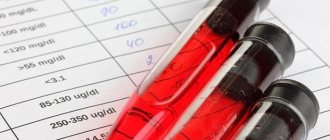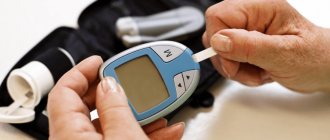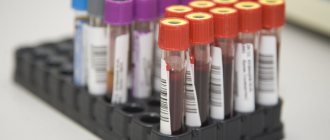Detailed description of the study
Immunoglobulin E (IgE) is one of 5 classes of immunoglobulins (IgM, IgG, IgD, IgA, IgE) in the human body. In the absence of pathology, IgE is detected in the bloodstream in very low concentrations, approximately 300 times lower than that of IgG. Not only does it have a unique chemical structure, but it is also involved in a number of physiological functions, such as protection against parasitic infections and even toxic substances. In addition, IgE plays a key role in the development of allergic diseases and atopic dermatitis.
The first contact with a protein-allergen usually goes unnoticed by a person, since the immune system does not yet have a sufficient amount of specific IgE to carry out a full-fledged allergic reaction. This condition is called sensitization.
A repeated encounter with a substance that provokes an allergy leads to its absorption by immune cells, with which IgE combines. In order for IgE to perform its functions, it must bind to cells such as eosinophils, basophils and some others.
The reaction occurs quite quickly, and allergy symptoms can develop just a few minutes after encountering the allergen, so it is classified as hypersensitivity I, or immediate type. The attachment of IgE to these cells leads to a cascade of reactions that ultimately contribute to the release of histamine granules - a substance that provokes vasodilation, contraction of the smooth muscles of the respiratory tract, which is the cause of allergy symptoms.
A person may experience a wide range of clinical manifestations: nasal congestion, runny nose, sneezing, dry cough, watery eyes and burning eyes if the allergen is in the air. Nausea or vomiting, diarrhea if it enters the digestive tract. Rash like urticaria in case of contact with skin.
Estimation of the total amount of IgE serves as a valuable diagnostic marker of allergies in both children and adults. With this disease, the level of these antibodies in the blood is increased.
Other reasons for increased circulation of these immunoglobulins in the blood include parasitic infections and some immunodeficiencies, but they are quite rare.
4.What are the risks and what could interfere with the analysis?
What are the risks of an antibody blood test?
If you take a blood test for antibodies, then possible risks may be associated only with blood sampling. In particular, the appearance of bruises at the site of blood sampling and inflammation of a vein or artery (phlebitis). Warm compresses several times a day will relieve phlebitis. If you are taking blood thinning medications, you may bleed at the puncture site.
What can interfere with an immunoglobulin test?
A blood test for immunoglobulin may be useless for the following reasons:
- Taking certain medications. Tell your doctor about all the medications you are taking;
- Treating cancer with chemotherapy or radiation therapy;
- Blood transfusion six months ago or less;
- Vaccination, especially repeated vaccination;
- Alcohol or other intoxication;
- Radiation examination three days before the test.
References
- Godwin, L., Crane, J. Biochemistry, ImmunoglobulinE (IgE). StatPearls Publishing, 2021.
- MAYO Clinic Laboratories : website / Test ID: IGE Immunoglobulin E (IgE), Serum, 2021.
- Derya, U., Gelincik, A., Elitok, A. et al. Impact of high serum Immunoglobulin E levels on the risk of atherosclerosis in humans. AsiaPacAllergy, 2021. - Vol. 7(2). — P. 74-81.
- Joshi, A., Iyer, V., Boyce, T. et al. Elevated serum immunoglobulin E (IgE): when to suspect hyper-IgE syndrome-A 10-year pediatric tertiary care center experience. AllergyAsthmaProc., 2009. - Vol. 30(1). — P. 23-27.
- American Academy of allergy asthma and immunology: website / AAAAI, 2021. - URL: https://www.aaaai.org/ (accessed March 15, 2021).
Total immunoglobulin E
The level of total immunoglobulin E (Ig E) is the sum of all immunoglobulins E. The blood of a healthy person contains a very low concentration. The rate may increase with allergic inflammation. The first contact with an allergen does not yet trigger its production in the body. Subsequently, upon repeated contact with the allergen, the immune system starts the process of formation of Ig E. The lifespan of protective proteins is short. Therefore, Ig E immediately enters the tissues after increasing the level in the blood. In the absence of an allergen, the proteins disappear.
How to decipher a blood test for total immunoglobulin E
The following indicators are considered reference values for immunoglobulin E in children:
- 0-3 months: from 0 to 2 kU/l;
- 3-6 months: from 3 to 10 kU/l;
- 6-12 months: from 8 to 20 kU/l;
- 1-5 years: from 10 to 50 kU/l;
- 5-15 years: from 16 to 60 kU/l.
Normal levels of immunoglobulin E in adults can range from 20 to 100 kE/l.
Deviation from the above norms, revealed during a blood test for total immunoglobulin E in individuals of both childhood and adulthood, may indicate the presence of a particular disease in the body or the development of a pathological process in it. In this case, the patient is prescribed additional examinations, during which it is established what is causing the disorder.
Specific immunoglobulins E
If the level of total Ig E is elevated, it is necessary to find out what caused it. For this purpose, a specific Ig E is selected, aimed at opposing a specific substance. To save time on searching for an allergen, ready-made panels have been created: food panel, inhalation panel, pediatric panel. They contain a complex of specific immunoglobulins to combat the most common allergens.
The medical doctor offers to make an appointment with a dermatologist. A full range of diagnostics and treatment of dermatological diseases in Tula. Tel. for recording.
Preparation:
No specific preparation is required. It is recommended to undergo the test on an empty stomach in the morning, or no earlier than 4 hours after the last meal. The drinking regime of clean water does not affect the analysis results.
To carry out the analysis, blood is taken from a person’s vein and applied to special test strips. On the same day, it is possible to get a result that will help you understand whether the person who applied has been infected with the COVID-19 coronavirus or not.
To register for a study
and for more detailed information, please call our call center +7-495-681-23-45, or leave a request for a call back.
Take care of yourself and your loved ones!
Types of immunoglobulins
Depending on the structure and function, immunoglobulins are divided into five main classes: G, M, E, A and D.
Immunoglobulin G(IgG)
This type of immunoglobulins constitutes the main class. It is found in blood serum and, in turn, is divided into four subclasses (IgG1, IgG2, IgG3, IgG4), each of which has its own unique functions. The production of immunoglobulin G occurs a few days after the production of immunoglobulin M, after which it remains in the body for a long period of time. Thanks to its anti-infective and anti-parasitic properties, immunoglobulin G ensures the elimination of infections, all kinds of viruses and fungi.
Immunoglobulin M (IgM)
The production of immunoglobulin M in the human body begins immediately after foreign agents enter it. These antibodies are called “alarming”. At the beginning of the development of any disease, there is a rapid increase in their number. The main task of immunoglobulins M is to provide the body’s initial defense when infections occur.
Immunoglobulin E (IgE)
Immunoglobulins E are specific antibodies, the appearance of which can be caused by an atopic type of allergy or worms. As a rule, normal immunoglobulin E is almost not observed in the blood.
Immunoglobulin A (IgA)
These antibodies help form local immunity of the mucous membranes. Immunoglobulins A are activated during the development of acute respiratory diseases and skin infections. Indicators of this type of immunoglobulin are increased in people suffering from alcoholism, chronic liver disease, and also in cases of poisoning.
Immunoglobulin D (IgD)
Immunoglobulin D (IgD) are antibodies with poorly understood functions to date. Most often they are part of medications.
Why take antibody tests?
New methods of examination make all those who suffered from suspicious ARVI and bronchitis in the fall and winter want to get tested and answer the main question: is there immunity to SARS-CoV-2? Antibody testing can also help in making a decision about the possibility of returning people from the quarantine regime to public life.
For the initial antibody test, it is recommended to detect both IgM and IgG antibodies in the blood. Thus, the study indicates a current or recent infection.
Prices
| Type of study | Type of study | Base price | Execution mode | Biomaterial | |
| Ordinary | Urgent | ||||
| IMMUNOLOGICAL STUDIES | |||||
| IMMUNOGLOBULINS | |||||
| IgA (immunoglobulin A) | quantity | Check with the call center | 1 w.d. | 2-5 hours | Blood syringe |
| IgM (immunoglobulin M) | quantity | Check with the call center | 1 w.d. | 2-5 hours | Blood syringe |
| IgG (immunoglobulin G) | quantity | Check with the call center | 1 w.d. | 2-5 hours | Blood syringe |
| IgE (immunoglobulin E) | quantity | Check with the call center | 1 w.d. | 2-5 hours | Blood syringe |
| Circulating immune complexes (CIC) | quantity | Check with the call center | 4 w.d. | — | Blood syringe |
| COMPLEMENT | |||||
| Complement component C3 | quantity | Check with the call center | 3 w.d. | — | Blood syringe |
| Complement component C4 | quantity | Check with the call center | 3 w.d. | — | Blood syringe |
| IMMUNE STATUS (Attention! BM is accepted only from Monday to Wednesday inclusive. It is not stored!) | |||||
| Basic immune status (complex on the main parameters of cellular and humoral immunity) - Leukocytes (abs. count), Leukocyte-T-lymphocyte index, CD3+ (abs. and relative count), 0-lymphocytes (abs. and relative count) . count), CD19+ (abs. and relative count), CD16/56+ (abs. and relative count), CD3/16/56+ (abs. and relative count), CD3/4+ (abs. and relative count), CD3/8+ (abs. and relative count), CD4+/CD8+ (abs. and relative count), CD4/CD8 immunoregulatory index, Lymphocytes include. quantity), IgG, IgM, IgA, C3 complement component, C4 complement component | quantity | Check with the call center | 4 w.d. | — | Blood serum+EDTA blood |
| Immune status extended (complex on the parameters of cellular and humoral immunity and phagocytic activity of leukocytes) - Leukocytes (abs. count), Leukocyte-T-lymphocyte index, CD3+ (abs. and relative count), 0-lymphocytes (abs. . and relative count), CD19+ (abs. and relative count), CD16/56+ (abs. and relative count), CD3/16/56+ (abs. and relative count) in), CD3/4+ (abs. and relative count), CD3/8+ (abs. and relative count), CD4+/CD8+ (abs. and relative count), CD4 immunoregulatory index /CD8, Lymphocytes refers. quantity), IgG, IgM, IgA, C3 complement component, C4 complement component, FG phagocytosis index, FM phagocytosis index, Phagocytic granulocytes (PG), Phagocytic monocytes (FM) | quantity | Check with the call center | 4 w.d. | — | Blood serum + EDTA blood + Blood with heparin |
Make an appointment
Study of the level of total immunoglobulin E in the blood
Antibodies of the IgE class are responsible for the development of allergic reactions.
General information about the study:
Immunoglobulins E are produced locally, mainly in the submucosal layer of tissues in contact with the external environment: in the skin, respiratory tract, gastrointestinal tract, tonsils, adenoids. The content of IgE in the blood is negligible. The half-life of these immunoglobulins in blood serum is 2 - 3 days, and in the skin - 9 - 14 days. When an allergen enters the body, it interacts with IgE. When immunoglobulins E adsorbed on cells come into contact with an allergen, “IgE - specific antigen” complexes are formed, which is accompanied by the entry of calcium ions into the target cell, activation of biochemical processes in it and the release of histamine and other biologically active substances from mast cells, basophils and eosinophils , on the membrane of which IgE is fixed. The entry of histamine and other cytotoxic substances into the intercellular space leads to the development of a local inflammatory reaction, manifested in the form of rhinitis, bronchitis, asthma, rash, or forms a systemic reaction in the form of anaphylactic shock. The synthesis of immunoglobulin E begins in the fetus at the 11th week of intrauterine development. It does not penetrate the placenta. A high level of IgE in umbilical cord blood is an indicator of a high risk of atopic diseases. Class E immunoglobulins (reagins) are gamma globulins in structure, which are produced by B lymphocytes. Immunoglobulins E are more associated with atopic diseases such as urticaria, allergic rhinitis, atopic dermatitis, and bronchial asthma. In addition, immunoglobulins E are involved in the formation of an antiparasitic immune response to toxoplasma, roundworm, echinococcus, trichinella, nematodes and other parasites. Also, a change in the concentration of reagins in a blood test for immunoglobulin E may be due to a genetic predisposition and may be observed in certain immunodeficiencies and in patients with pulmonary aspergillosis. Thus, 75% of children whose parents suffer from allergic diseases have an increase in Ig E levels.
Indications for this study:
- assessment of the risk of an allergic reaction in children (Ig E level as a prognostic indicator);
- assessment of the immune status of the body as a whole;
- diagnosis of helminthic infestations;
- differential diagnosis of hypersensitivity reactions among diseases with similar symptoms (dermatitis, chronic rhinitis, other diseases of the upper respiratory tract);
- assessment of the effectiveness of treatment of allergic diseases, as well as pulmonary aspergillosis;
- diagnosis of some immunopathological diseases;
- for an objective assessment of sensitization to a specific allergen.
What to do?
To get reliable results from an immunoglobulin E test, it is worth preparing for blood donation correctly.
- Determination of Ig E is carried out only at the peak of an exacerbation of the disease in the presence of obvious symptoms: rash and burning, nasal congestion, runny nose. Otherwise, the analysis will not show anything.
- On the eve of the test, it is necessary to keep a food diary, taking into account the presence of symptoms. This will help the allergist make more accurate conclusions and prescribe the appropriate panel.
- To confirm the allergic nature of the inflammation, in some cases it is worth taking an analysis for the cationic protein of eosinophils.
The study is recommended for:
- Food allergies;
- Drug allergies;
- Allergies to pollen;
- Ascariasis;
- Intestinal nematode;
- Echinococcosis;
- Amoebiosis;
- Hookworm;
- Bronchial asthma;
- Rhinitis;
- Sinusitis;
- Dermatitis;
- Hives;
- Quincke's edema;
- High level of eosinophils;
- Allergic bronchopulmonary aspergillosis;
- IgE myeloma;
- DiGeorge syndrome;
- Nodular periarthritis;
- Wiskott-Aldrich syndrome;
- Jobe-Buckley syndrome;
- Neumann's syndrome.
Method:
Enzyme-linked immunosorbent assay (ELISA).
Sensitivity:
Not less than 2.5 IU/ml.
Material for research:
Blood serum.







